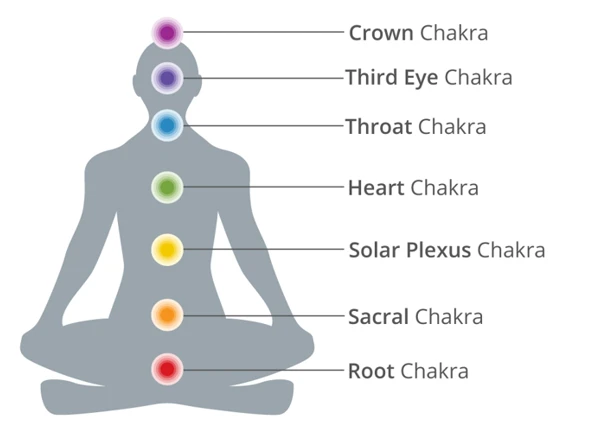Welcome to the Vibrant World of Chakras! Have you ever wondered about those mystical energy centers within your body that are said to hold the key to your well-being? The seven chakras, each with its distinct characteristics and functions, form an integral part of ancient Eastern philosophies. Understanding the intricate balance and harmonious flow of energy through these chakras can help you achieve a higher level of self-awareness and spiritual growth. So, let’s embark on a captivating journey where we explore the definitions, locations, functions, imbalances, and healing methods associated with each of these fascinating energy centers. From the grounding Root Chakra to the enlightening Crown Chakra, get ready to unlock the secrets of your inner being and unleash a wave of vitality and vitality. Get ready to delve into the depths of your consciousness and discover the power of the seven chakras!
Contents
- The Root Chakra
- The Sacral Chakra
- The Solar Plexus Chakra
- The Heart Chakra
- The Throat Chakra
- The Third Eye Chakra
- The Crown Chakra
- Conclusion
-
Frequently Asked Questions
- What are chakras?
- What is the purpose of the chakras?
- How do chakras affect our daily lives?
- Can we physically see chakras?
- What are some signs of chakra imbalances?
- How can we balance our chakras?
- What is the significance of colors in chakras?
- Can chakra imbalances affect mental well-being?
- Can practicing yoga help balance the chakras?
- How can understanding the chakras enhance personal growth?
- References
The Root Chakra
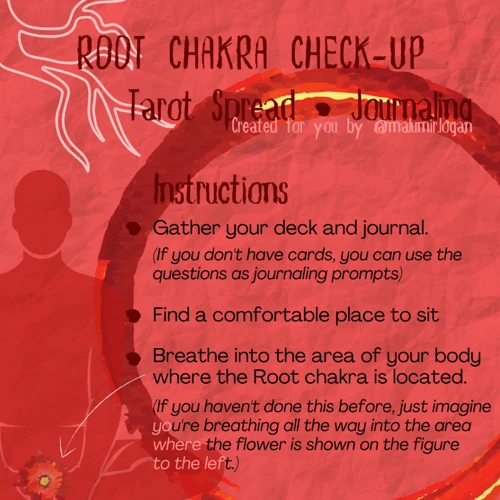
The Root Chakra, also known as the Muladhara Chakra, is the foundation of the chakra system, located at the base of the spine. This first chakra is associated with our sense of grounding, stability, and security. It is symbolized by the color red, representing vitality and strength. The Root Chakra acts as a support system for our physical and emotional well-being, connecting us to the Earth’s energy. When in balance, it instills a sense of belonging, courage, and stability. However, imbalances in this chakra can lead to feelings of fear, anxiety, and insecurity. Healing practices such as meditation and chakra balancing through yoga can help restore harmony to the Root Chakra, ensuring a strong and stable foundation for personal growth and well-being.
Definition and Location
The Root Chakra, also known as Muladhara Chakra, is the first energy center in the chakra system. It is located at the base of the spine, near the perineum. The word “Muladhara” in Sanskrit translates to “root support” or “foundation.” This chakra is associated with our physical connection to the Earth and represents our sense of stability, security, and groundedness. The Root Chakra is symbolized by the color red and is linked to the element of earth. It governs our basic survival needs, including food, shelter, and safety. When the Root Chakra is balanced, we feel secure, rooted, and able to face life’s challenges with confidence. However, imbalances in this chakra can lead to feelings of fear, insecurity, and instability. To restore balance to the Root Chakra, practices such as yoga chakra balancing and grounding exercises can be immensely helpful. By aligning and nourishing the Root Chakra, we can enhance our overall well-being and strengthen our mental and emotional foundations, leading to a greater sense of stability and mental well-being. To learn more about the impact of chakra imbalances on mental well-being, you can read our comprehensive article on chakra imbalances and mental well-being.
Functions and Energy
The Functions and Energy of the Root Chakra revolve around our basic survival instincts, physical vitality, and connection to the physical world. This essential chakra governs our sense of safety, security, and stability, both on a physical and emotional level. It acts as the foundation for our entire energy system, providing us with a strong base to build upon. The Root Chakra is responsible for grounding us to the Earth’s energy, enabling us to feel rooted and connected. It helps us stay present in the moment and enables us to meet our basic needs for survival, such as food, shelter, and safety. When the Root Chakra is balanced and functioning optimally, it provides us with a sense of confidence, courage, and belonging. It fuels our desire for physical well-being and helps us take the necessary actions to ensure our overall health. It also fosters a deep connection to nature and promotes a sense of stability and abundance in our lives. However, imbalances in this chakra can lead to feelings of insecurity, fear, and instability. It may manifest as physical symptoms like lower back pain, digestive issues, or immune system imbalances. To restore balance to the Root Chakra, practices such as grounding exercises, physical activities like yoga or tai chi, and spending time in nature can be highly beneficial. These practices help us reconnect with our physical bodies and the Earth’s energy, allowing us to feel secure, stable, and fully present in our lives. By nourishing and balancing the Root Chakra, we can establish a solid foundation from which we can grow and thrive in every aspect of our lives.
Imbalances and Healing
Imbalances and Healing – When the Root Chakra is imbalanced, it can manifest in various physical, emotional, and mental symptoms. Physical symptoms may include lower back pain, constipation, and issues with the immune system. Emotionally, imbalances in the Root Chakra can lead to feelings of fear, insecurity, and a lack of stability. Mentally, it can result in a lack of focus, difficulty making decisions, and a sense of being disconnected from reality. Healing the Root Chakra involves bringing it back into balance and restoring its energy flow. There are several techniques that can aid in this process. Grounding exercises, such as walking barefoot in nature or practicing root chakra yoga poses, can help establish a connection with the Earth’s energy. Using affirmations that promote feelings of safety, security, and stability can also be beneficial. Healing crystals, like red jasper or hematite, can be used to balance the energy of the Root Chakra. Additionally, incorporating grounding foods such as root vegetables and practicing mindfulness meditation can help restore harmony to the Root Chakra. By addressing and healing imbalances in the Root Chakra, individuals can experience improved physical vitality, a sense of stability, and a strong foundation for personal growth and well-being.
The Sacral Chakra
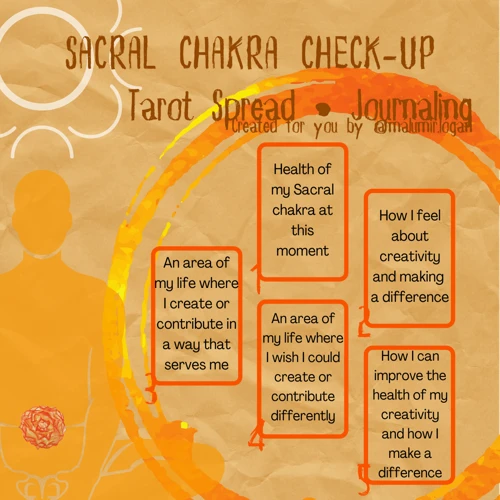
The Sacral Chakra, also known as the Svadhisthana Chakra, is the second chakra located in the lower abdomen, just below the navel. This chakra is associated with our emotions, creativity, passion, and sensuality. It is represented by the color orange, which symbolizes warmth and enthusiasm. The Sacral Chakra is responsible for our ability to experience pleasure, connect with others, and embrace our desires. When this chakra is balanced, we feel a sense of creativity, abundance, and emotional well-being. However, imbalances in the Sacral Chakra can lead to feelings of emotional instability, lack of creativity, and difficulty in forming healthy relationships. Healing practices such as meditation, expressing oneself through art, and practicing yoga can help restore balance to the Sacral Chakra. By nurturing our creative and emotional selves, we can tap into the immense potential and joy that this chakra has to offer.
Definition and Location
The Root Chakra, also known as the Muladhara Chakra, is the first energy center in the chakra system. Its name, Muladhara, is derived from two Sanskrit words: “mula,” meaning root, and “adhara,” meaning support or base. As the name suggests, this chakra serves as the foundation for our entire energy system. It is located at the base of the spine, at the perineum, and is closely connected to the coccyx bone. This chakra is associated with the element of earth, and its energetic focus lies on our basic survival instincts, physical health, and sense of stability and security. When the Root Chakra is balanced and open, we feel grounded, secure, and connected to the world around us. It gives us a solid foundation to build upon, enabling us to navigate life’s challenges with resilience and strength. It is crucial to ensure the Root Chakra is in balance to establish a strong base for the other chakras to function optimally.
Functions and Energy
The Functions and Energy of the Root Chakra are deeply connected to our sense of stability, grounding, and physical well-being. This root chakra is responsible for our connection to the Earth and serves as the foundation for our entire chakra system. It governs our basic survival needs, including our sense of safety, security, and primal instincts. The energy of the Root Chakra helps us to feel grounded and rooted in the present moment, allowing us to navigate through life with a sense of stability and strength. It also plays a crucial role in our physical health, as it is associated with the organs and systems in the lower body, such as the legs, feet, and spine. When the Root Chakra is in balance, we feel a deep sense of security, confidence, and trust in ourselves and the world around us. We are able to manifest our desires and feel connected to our purpose in life. However, imbalances in this chakra can manifest as a sense of fear, insecurity, and a lack of grounding. This can lead to physical ailments, as well as a disconnection from our bodies and the world around us. To restore balance to the Root Chakra, practices such as grounding exercises, yoga poses that focus on the lower body, and connecting with nature can be beneficial. These practices help to strengthen the energy flow in the Root Chakra, allowing us to feel more grounded, centered, and in touch with our physical and energetic bodies.
Imbalances and Healing
Imbalances in the Root Chakra can manifest in various ways, impacting both our physical and emotional well-being. When this chakra is blocked or imbalanced, you may experience a lack of security, feeling disconnected from your body or the world around you. On the other hand, an overactive Root Chakra may result in excessive materialism, stubbornness, or a fear of change. However, there are several effective methods for healing and balancing the Root Chakra.
One powerful approach is through grounding exercises, which involve connecting with the Earth’s energy. Walking barefoot in nature, practicing gardening, or simply sitting on the ground can help restore balance to the Root Chakra. Additionally, using grounding crystals like red jasper or hematite can support energetic healing. Incorporating yoga poses such as the Mountain Pose (Tadasana) or the Child’s Pose (Balasana) into your daily routine can also help activate and balance this chakra.
Adopting a healthy lifestyle that focuses on physical well-being can have a positive impact on the Root Chakra. Engaging in regular exercise, maintaining a balanced diet, and getting sufficient restful sleep are all essential in promoting a sense of stability and groundedness.
Meditation and breathwork practices can also aid in healing the Root Chakra. Visualizing a vibrant red light at the base of your spine during meditation can help energize and balance this chakra. Deep, mindful breathing techniques, such as the 4-7-8 breath, can encourage a sense of calm and grounding.
Lastly, exploring and healing past traumas or childhood experiences that are related to safety or security can be beneficial for healing the Root Chakra. This can be done through therapy, energy healing modalities, or self-reflection practices.
By incorporating these various approaches into your daily life, you can begin to heal imbalances in the Root Chakra, fostering a sense of stability, security, and connection to the world around you. Remember, every small step toward balance and healing is a meaningful journey towards overall well-being.
The Solar Plexus Chakra
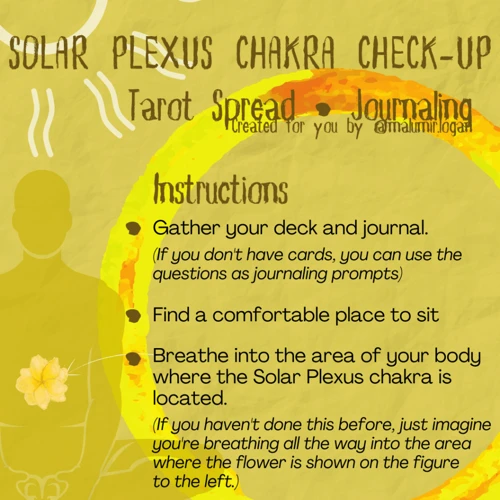
The Solar Plexus Chakra, also known as the Manipura Chakra, is an energetic center located in the upper abdomen, around the navel area. Represented by the color yellow, this third chakra is associated with personal power, confidence, and self-esteem. It serves as our emotional and spiritual support system, influencing our sense of identity and purpose. When the Solar Plexus Chakra is balanced, we feel a strong sense of personal empowerment, motivation, and assertiveness. However, imbalances in this chakra can lead to feelings of low self-esteem, indecision, and a lack of self-confidence. To bring healing and balance to the Solar Plexus Chakra, activities such as meditation and yoga can be tremendously beneficial. By embracing our inner strength and nurturing our self-worth, we can tap into the immense potential of the Solar Plexus Chakra and experience a profound transformation in our lives.
Definition and Location
The Root Chakra, or Muladhara Chakra, is the foundation of the seven chakras and is associated with our sense of grounding, stability, and security. It is located at the base of the spine, between the genitals and the anus. The name “Muladhara” translates to “root support” in Sanskrit, signifying its role as the root and foundation of our energy system. This first chakra connects us to the physical world and the Earth’s energy, serving as the anchor for our entire being. It is symbolized by the color red, which represents vitality, survival, and strength. The Root Chakra is responsible for our sense of safety, stability, and our basic needs, such as food, shelter, and financial security. When the Root Chakra is balanced and energized, we feel secure, grounded, and connected to the world around us. However, imbalances in the Root Chakra can manifest as fear, anxiety, restlessness, or a feeling of being “ungrounded.” Understanding the definition and location of the Root Chakra is the first step in exploring how to maintain its balance and support our overall well-being.
Functions and Energy
- Governing Physicality: The Root Chakra is responsible for our physical well-being and the connection to the physical world. It governs our survival instincts, providing us with a strong sense of safety and security.
- Grounding and Stability: This chakra acts as an anchor, keeping us grounded to the Earth’s energy and providing a stable foundation for our lives. It helps us feel rooted and connected, enabling us to navigate through life’s challenges with resilience and stability.
- Supporting Emotional Balance: The Root Chakra plays a vital role in managing our emotions. When balanced, it promotes a sense of calmness, emotional stability, and the ability to handle stress effectively. It helps us feel centered and secure, allowing us to build strong emotional foundations.
- Manifestation and Materialization: This chakra is closely associated with the manifestation of our goals and desires. When our Root Chakra is balanced, we are more capable of bringing our dreams into reality and attracting abundance in our lives.
- Transforming Fear: The Root Chakra assists in transforming fear into courage, providing a sense of safety that nurtures self-confidence and personal empowerment. It helps us overcome obstacles and face challenges head-on without succumbing to fear or insecurity.
The energy of the Root Chakra is focused downwards, grounding and connecting us to the Earth’s energy. It is associated with the element of earth, representing stability and solidity. When this energy is flowing harmoniously through the chakra, we experience a strong sense of physical and emotional well-being. However, imbalances in the energy flow of the Root Chakra can manifest as physical ailments, emotional instability, or a sense of being disconnected from our surroundings. It is essential to nurture and maintain the balance of this chakra to ensure overall harmony and a solid foundation for our well-being.
Imbalances and Healing
Imbalances in the Root Chakra can manifest in various ways, affecting both our physical and emotional well-being. When this chakra is overactive, individuals may experience feelings of aggression, greed, and a tendency to be overly controlling. On the other hand, an underactive Root Chakra can result in feelings of insecurity, lack of motivation, and a disconnect from the physical world.
To heal and restore balance to the Root Chakra, several practices can be implemented. Grounding exercises, such as walking barefoot in nature or practicing yoga poses that focus on stability, can help reconnect with the Earth’s energy. Engaging in activities that promote feelings of safety and security, such as creating a stable routine or surrounding oneself with a supportive community, can also help restore balance to the Root Chakra. Additionally, incorporating red-colored foods, such as beets and red peppers, into the diet can nourish and energize this chakra.
Crystals such as red jasper, hematite, and garnet can be used in chakra healing to stimulate and balance the Root Chakra. Placing these crystals near the base of the spine during meditation or carrying them throughout the day can help align the chakra’s energy. Aromatherapy can also aid in healing the imbalances of the Root Chakra, with grounding scents like patchouli, cedarwood, and sandalwood promoting a sense of security and stability.
By addressing imbalances in the Root Chakra, individuals can cultivate a stronger connection to their physical bodies, build a solid foundation in life, and enhance feelings of stability and security. With a balanced Root Chakra, one can confidently navigate through life’s challenges and thrive in all aspects of their being.
The Heart Chakra

The Heart Chakra, also known as the Anahata Chakra, is the fourth chakra located at the center of the chest. Represented by the color green, this chakra signifies love, compassion, and emotional balance. It serves as the bridge between the lower three chakras associated with our physical needs and the upper three chakras connected to our spiritual growth. The Heart Chakra governs our ability to give and receive love, nurturing harmonious relationships, and fostering self-acceptance and forgiveness. When this chakra is in balance, we experience deep connections with others, empathy, and a sense of inner peace. However, imbalances in the Heart Chakra can manifest as feelings of grief, jealousy, or an inability to form meaningful connections. Engaging in activities that promote self-care, practicing gratitude, and balancing the chakras through yoga can help restore equilibrium to the Heart Chakra, allowing us to open our hearts to love and compassion, both for ourselves and others.
Definition and Location
The Root Chakra, also known as the Muladhara Chakra, is the first energy center in the chakra system. It is located at the base of the spine, near the tailbone or coccyx. This chakra governs our sense of grounding, stability, and connection to the physical world. It is associated with the element of Earth, providing us with a solid foundation for personal growth and well-being. The Root Chakra is symbolized by the color red, which represents vitality, strength, and energy. When this chakra is balanced and functioning optimally, it allows us to feel secure, grounded, and deeply rooted in our physical existence. It gives us a sense of stability, enabling us to navigate life’s challenges with resilience and confidence. Understanding the definition and location of the Root Chakra is the first step towards harnessing its powerful energy and unlocking its healing potential.
Functions and Energy
The Root Chakra, being the foundation of the chakra system, plays a crucial role in our physical and emotional well-being. Its main function is to provide a sense of stability, grounding, and connection to the Earth’s energy. This energy center is responsible for our basic survival instincts, including our sense of safety, security, and protection. It governs our physical needs such as food, shelter, and safety, and helps us feel a sense of belonging to our family, community, and the world around us. The Root Chakra also influences our connection with our physical bodies, helping us stay grounded and present in the here and now. When this chakra is balanced and functioning optimally, we feel a strong sense of stability, courage, and confidence in ourselves and our ability to navigate through life’s challenges. It provides a solid foundation for personal and spiritual growth.
Imbalances and Healing
Imbalances in the Root Chakra can manifest in various ways, affecting both our physical and emotional well-being. When the Root Chakra is underactive or blocked, individuals may experience feelings of insecurity, fear, and a lack of stability. They may struggle with low self-esteem or have difficulty establishing healthy boundaries. Physical symptoms could include issues with the lower back, legs, or feet.
On the other hand, an overactive Root Chakra can lead to an excessive attachment to material possessions or a resistance to change. This can result in feelings of greed, aggression, or a need for control. Physical symptoms might include digestive problems or high blood pressure.
To heal imbalances in the Root Chakra, various methods can be employed. Grounding exercises, such as walking barefoot in nature or practicing yoga, can help establish a connection with the Earth’s energy. Deep breathing exercises and meditation techniques focused on affirming one’s safety and security can also be beneficial.
Incorporating red-colored foods like beets, tomatoes, and strawberries into your diet can help stimulate and balance the Root Chakra. Using grounding crystals such as hematite, red jasper, or smoky quartz can also aid in chakra healing.
Remember, chakra healing is a holistic practice, and it is important to address imbalances in all areas of life, including emotional, physical, and spiritual aspects. By taking the time to nurture and balance the Root Chakra, we can lay a solid foundation for overall well-being and personal growth.
The Throat Chakra
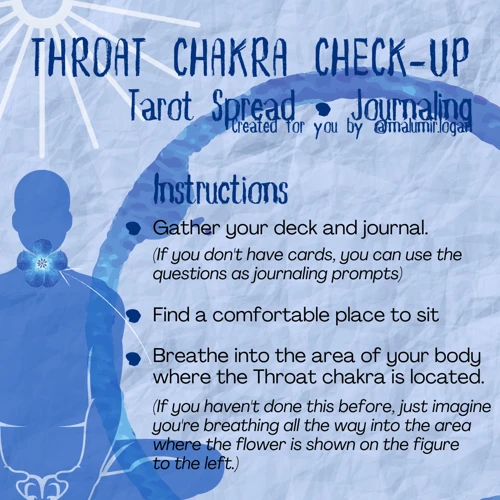
The Throat Chakra, also known as the Vishuddha Chakra, is the fifth chakra situated at the base of the throat. This energetic center represents communication, self-expression, and authenticity. Associated with the color blue, the Throat Chakra enables us to speak our truth and express our thoughts and emotions effectively. It also governs our ability to actively listen and engage in meaningful conversations. A balanced Throat Chakra allows us to express ourselves clearly and honestly, leading to harmonious relationships and a sense of inner peace. On the other hand, imbalances in this chakra can manifest as difficulties in self-expression, fear of judgment, or difficulties in speaking up. Healing techniques like chanting, practicing mindful speech, or engaging in creative activities can help balance and open the Throat Chakra, allowing us to communicate and connect with others in an authentic and empowered way.
Definition and Location
The Root Chakra, also known as the Muladhara Chakra, is the first of the seven chakras in the body’s energy system. It is located at the base of the spine, near the coccyx bone. Representing our connection to the physical world, the Root Chakra is associated with the element of earth. It is characterized by its grounding and stabilizing qualities, serving as the foundation for our entire chakra system. This chakra governs our basic survival needs, such as food, shelter, and safety, as well as our sense of belonging and connection to our family and community. When the Root Chakra is in balance, we feel secure, stable, and rooted in our existence. However, imbalances in this chakra can manifest as feelings of insecurity, fear, and instability. It is important to nurture and maintain a healthy Root Chakra to ensure a strong foundation for our overall well-being and personal growth.
Functions and Energy
The Root Chakra is responsible for a range of functions and energy that contribute to our overall well-being. Its primary function is to establish a strong connection between our physical bodies and the Earth’s energy. This chakra governs our sense of stability, security, and survival instincts. When the Root Chakra is balanced, it allows us to feel grounded, centered, and confident in ourselves and our abilities. It provides us with a deep sense of belonging and allows us to feel rooted in the present moment. The energy of the Root Chakra is associated with qualities like strength, courage, and resilience. It provides the foundation for personal and spiritual growth, enabling us to navigate through life’s challenges with stability and determination. A balanced Root Chakra also supports physical health, influencing the proper functioning of our bones, muscles, and immune system. It can enhance our vitality and endurance, allowing us to feel energized and motivated. By focusing on nurturing and balancing the energy of the Root Chakra, we can experience a greater sense of stability, security, and overall well-being in our lives.
Imbalances and Healing
Imbalances in the Root Chakra can manifest in various ways, affecting both our physical and emotional well-being. When the Root Chakra is deficient, individuals may experience feelings of insecurity, fear, anxiety, and a lack of grounding. They may struggle with chronic fatigue, unexplained physical ailments, and a weakened immune system. On the other hand, an excessive Root Chakra can lead to materialism, greed, aggressiveness, and an overemphasis on earthly possessions.
Fortunately, there are numerous healing techniques that can restore balance to the Root Chakra. Here are some effective methods:
1. Grounding Meditation: Practicing grounding meditation can help individuals reconnect with the Earth’s energy, promoting a sense of stability and security. This involves sitting comfortably, closing your eyes, and visualizing roots growing from the base of your spine, anchoring you to the ground.
2. Physical Exercise: Engaging in physical activities such as walking, hiking, or yoga can help ground and energize the Root Chakra. These exercises connect the body with the Earth, allowing for the release of excess energy and promoting balance.
3. Use of Affirmations: Repeating positive affirmations that focus on feelings of security, stability, and strength can be beneficial for balancing the Root Chakra. Affirmations such as “I am safe and secure” or “I trust in the process of life” can help shift negative thought patterns.
4. Crystal Healing: Crystals such as red jasper, garnet, and hematite are often used to balance the Root Chakra. Placing these crystals on or near the chakra point, or carrying them as pocket stones, can help restore equilibrium and enhance feelings of stability.
5. Aromatherapy: Certain essential oils have grounding properties that can aid in Root Chakra healing. Oils such as patchouli, vetiver, and cedarwood can be diffused or applied topically to promote a sense of stability and security.
By incorporating these practices into your routine, you can address imbalances in the Root Chakra and promote overall well-being. Remember, finding balance in the Root Chakra is essential for establishing a solid foundation for personal growth and self-awareness.
The Third Eye Chakra
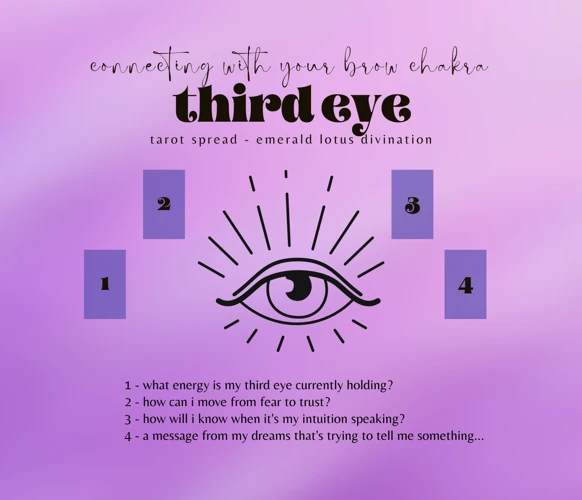
The Third Eye Chakra, known as the Ajna Chakra, is the sixth chakra in the energy system and is located between the eyebrows. This chakra is associated with intuition, perception, and spiritual awareness. It is symbolized by the color indigo, representing inner wisdom and deep insight. The Third Eye Chakra acts as a doorway to the higher realms of consciousness, allowing us to tap into our inner guidance and connect with our higher selves. When balanced, it enhances our intuition, imagination, and clarity of thought. However, imbalances in this chakra can lead to a lack of focus, confusion, and an inability to trust our intuitive abilities. Practices such as meditation and visualization can help open and balance the Third Eye Chakra, allowing us to access our inner wisdom and gain a deeper understanding of ourselves and the world around us.
Definition and Location
- The Root Chakra, also known as the Muladhara Chakra, is the first chakra in the seven-chakra system.
- Its name “Muladhara” originates from the Sanskrit words “mula,” meaning “root,” and “adhara,” meaning “support” or “base.” Hence, it is often referred to as the “Root” or “Base” Chakra.
- The location of the Root Chakra is at the base of the spine, near the pelvic floor. It is positioned between the genitals and the anus.
- This chakra is often associated with the element of earth, representing stability, grounding, and physicality.
- Being the foundation of the chakra system, the Root Chakra is the energetic link to our connection with the physical world, our survival instincts, and our overall sense of stability and security. It governs our basic needs, such as food, shelter, and safety.
- Having a strong and balanced Root Chakra is essential for creating a solid foundation upon which we can build our lives and pursue higher spiritual growth.
Functions and Energy
The Root Chakra, the first energy center of the seven, governs a variety of functions and energy dynamics within our physical and emotional bodies. Its primary function is to ground us to the Earth, providing a sense of stability, security, and connection. This essential chakra is responsible for our survival instincts, as well as our ability to feel safe and secure in the world. It influences our physical vitality, our sense of belonging, and our ability to manifest our basic needs.
The energy of the Root Chakra flows downward, like the roots of a tree, grounding us and connecting us to the Earth’s energy. This energy helps us maintain a sense of presence and stability in the physical world. It provides us with the strength and courage to face challenges, and it supports our overall physical well-being.
The Root Chakra’s energy is associated with the element of Earth, which represents solidity, strength, and nourishment. When this chakra is balanced and functioning optimally, we feel a deep sense of being rooted and supported. We have a strong connection to our physical body and the physical world around us.
To keep the Root Chakra in balance, it is important to engage in activities that promote grounding and stability. These can include walking barefoot in nature, practicing yoga poses that focus on the lower body, such as Tree Pose or Mountain Pose, and incorporating grounding foods into our diet, such as root vegetables.
By understanding the functions and energy dynamics of the Root Chakra, we can become more aware of how this vital energy center influences our overall well-being. Taking time to nurture and balance the Root Chakra can provide a solid foundation for our physical, emotional, and spiritual growth.
Imbalances and Healing
Imbalances in the Root Chakra can manifest in various ways, affecting both our physical and emotional well-being. When this chakra is blocked or underactive, individuals may experience feelings of insecurity, fear, or a lack of stability. They may struggle with self-doubt and have difficulty trusting themselves or others. On the other hand, an overactive Root Chakra can result in an excessive need for control, aggression, or stubbornness.
To heal and restore balance to the Root Chakra, there are several effective practices one can engage in. Here are some methods to consider:
- Grounding exercises: Engaging in activities that help you connect with the Earth’s energy can be beneficial. This can include walking barefoot in nature, gardening, or practicing grounding meditation.
- Physical activity: Engaging in physical activities such as yoga, tai chi, or dance can help stimulate the Root Chakra and promote a sense of stability and strength.
- Using grounding crystals: Crystals like red jasper, hematite, or black tourmaline are believed to have grounding properties. Placing these crystals near the Root Chakra or carrying them with you can help restore balance.
- Aromatherapy: Using essential oils such as patchouli, cedarwood, or vetiver can promote a sense of grounding and stability when diffused or applied topically.
- Chakra healing practices: Engaging in chakra balancing techniques, such as Reiki or sound therapy, can help clear any blockages and restore the energy flow in the Root Chakra.
By incorporating these healing practices into your life, you can address imbalances in the Root Chakra and foster a sense of stability, security, and self-confidence. Remember, each individual may resonate with different healing methods, so it’s important to explore and find what works best for you.
The Crown Chakra
The Crown Chakra, also known as the Sahasrara Chakra, is the seventh and highest chakra in the system. Positioned at the top of the head, it represents our connection to the divine and the spiritual realm. This chakra is associated with pure consciousness, enlightenment, and transcendence. Symbolized by the color violet or white, the Crown Chakra radiates spiritual energy and divine wisdom. When balanced, it allows for a deep sense of spiritual connection, bliss, and inner peace. Imbalances in this chakra can manifest as feelings of disconnection, confusion, and spiritual emptiness. Healing techniques such as meditation, mindfulness, and energy work can help restore balance to the Crown Chakra, allowing for a greater sense of spiritual awakening and connection to the higher self. With an aligned Crown Chakra, one can experience a profound sense of purpose and spiritual fulfillment.
Definition and Location
The Definition and Location of the Root Chakra is a fundamental aspect of understanding this energy center. The Root Chakra, or Muladhara in Sanskrit, is the first chakra in the seven-chakra system. It is situated at the base of the spine, near the perineum, and extends downward towards the feet. This chakra embodies the element of Earth and represents our foundation, stability, and sense of belonging. It is associated with the color red and is connected to our physical bodies and the material world. The Root Chakra is responsible for grounding us to the present moment and providing a sense of security in our lives. When this chakra is in balance, we feel rooted, secure, and empowered. However, imbalances in the Root Chakra can manifest as anxiety, fear, restlessness, or a feeling of being ungrounded. Understanding the definition and location of the Root Chakra allows us to navigate our energy centers and work towards balancing and harnessing the power of this foundational chakra.
Functions and Energy
The Functions and Energy of the Root Chakra revolve around the fundamental aspects of our existence. This chakra is responsible for our sense of security, stability, and survival instincts. It is closely connected to our physical body, providing a solid foundation for our overall well-being. The Root Chakra governs our basic needs such as food, shelter, safety, and financial security. It helps us feel grounded and connected to the Earth, enabling us to navigate through life’s challenges with confidence and stability.
The energy of the Root Chakra is dense and grounded, representing the element of earth. It supports our physical energy and vitality, providing us with a strong sense of stability and endurance. When the Root Chakra is balanced and flowing freely, we feel a deep connection to our physical body and the world around us. We have a strong sense of self, and we are able to trust in ourselves and in the abundance of the universe.
Imbalances in the Root Chakra can manifest in various ways. When this chakra is deficient, we may experience feelings of fear, insecurity, and disconnection from our bodies. On the other hand, an excessive Root Chakra may lead to greed, materialism, and a rigid attachment to material possessions. It is essential to find a harmonious balance in the Root Chakra to cultivate a sense of stability, security, and trust in ourselves and in the world.
To support the healing and balancing of the Root Chakra, various practices can be incorporated into our daily lives. Grounding exercises, such as walking barefoot in nature or practicing yoga, can help us reconnect with the Earth’s energy. Engaging in activities that promote a sense of stability and security, such as organizing our physical space or establishing a regular routine, can also be beneficial. Additionally, exploring and healing any past traumas or fears related to our sense of safety and security can contribute to the overall well-being of the Root Chakra.
Understanding the functions and energy of the Root Chakra allows us to become more aware of our basic needs and the importance of establishing a solid foundation in our lives. By nurturing and balancing this chakra, we can cultivate a sense of stability, security, and strength that supports our overall well-being and personal growth.
Imbalances and Healing
Imbalances within the Root Chakra can have profound effects on our overall well-being. When the Root Chakra is deficient, individuals may experience feelings of insecurity, anxiety, and a lack of grounding. On the other hand, an excessive Root Chakra can manifest as aggression, stubbornness, and an obsession with material possessions. In order to restore balance to this chakra, various healing techniques can be employed. Grounding exercises such as walking barefoot in nature, gardening, or practicing yoga poses that focus on connecting with the Earth can help to anchor and stabilize the Root Chakra. Meditation and visualization techniques can also be beneficial, envisioning the color red and a strong foundation at the base of the spine. Additionally, working with crystals such as red jasper or hematite can aid in grounding and balancing the Root Chakra. By addressing and healing imbalances in the Root Chakra, we can cultivate a sense of stability, security, and a strong foundation for personal growth and transformation.
Conclusion
In conclusion, the seven chakras are powerful energy centers within our bodies that play a significant role in our overall well-being. Each chakra has its own unique characteristics, functions, and imbalances, which can greatly impact our physical, emotional, and spiritual health. By understanding the definitions and locations of each chakra, we can begin to recognize the intricate network of energy flowing through our bodies. The functions and energy associated with each chakra provide us with insights into the various aspects of our lives that they govern, from our sense of security to our ability to communicate and connect with others. It is important to be aware of any imbalances and healing methods specific to each chakra, as addressing these imbalances can lead to a more harmonious and balanced state of being. Whether through meditation, yoga, or other energy healing practices, it is crucial to take the time to nurture and maintain the health of our chakras. By doing so, we can enhance our self-awareness, promote personal growth, and ultimately experience a greater sense of vitality and well-being. The journey of understanding and working with the seven chakras is an ongoing and transformative process that offers profound benefits to individuals seeking to tap into their inner power and achieve a state of inner balance and harmony.
Frequently Asked Questions
What are chakras?
Chakras are energy centers within the body, according to ancient Eastern philosophies. There are seven main chakras, each associated with different functions and located along the body’s central energy channel.
What is the purpose of the chakras?
The purpose of the chakras is to regulate the flow of vital energy throughout the body, promoting physical, emotional, and spiritual well-being.
How do chakras affect our daily lives?
Chakras influence our thoughts, emotions, and actions. When balanced, they enhance our vitality, intuition, and connection to higher consciousness. Imbalances can manifest as physical or emotional issues.
Can we physically see chakras?
While chakras are not visible to the naked eye, some individuals with heightened sensitivity claim to see or perceive them as spinning wheels or vortexes of energy.
What are some signs of chakra imbalances?
Signs of chakra imbalances can include physical ailments, emotional instability, lack of motivation, and feeling disconnected from oneself or others.
How can we balance our chakras?
There are various methods to balance chakras, including meditation, yoga, breathwork, sound healing, and working with crystals. Each chakra can be balanced through specific practices and techniques.
What is the significance of colors in chakras?
Each chakra is associated with a specific color, representing its unique energy. Colors can be used in chakra healing practices, visualizations, and meditation to restore balance and vitality.
Can chakra imbalances affect mental well-being?
Yes, chakra imbalances can impact mental well-being. For example, an imbalanced Sacral Chakra can lead to feelings of self-doubt or creative blocks, while an imbalanced Third Eye Chakra can affect clarity of thought and intuition.
Can practicing yoga help balance the chakras?
Absolutely! Yoga is a powerful tool for chakra balancing. Specific yoga poses, known as asanas, can activate and harmonize the energy flow through different chakras, promoting balance and well-being.
How can understanding the chakras enhance personal growth?
Understanding the chakras allows us to identify areas of imbalance and work towards restoring harmony in our lives. By cultivating self-awareness and engaging in chakra-balancing practices, we can unlock our full potential and experience personal growth on physical, emotional, and spiritual levels.

